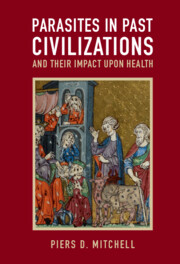Book contents
- Parasites in Past Civilizations and Their Impact upon Health
- Parasites in Past Civilizations and Their Impact upon Health
- Copyright page
- Contents
- Acknowledgements
- 1 Introduction
- 2 Near Eastern Civilizations
- 3 Ancient Egypt and Nubia
- 4 The Prehistoric Peoples of Europe
- 5 The Roman World
- 6 Medieval Europe
- 7 East Asian Civilizations
- 8 North American Indigenous Peoples
- 9 South and Central American Civilizations
- 10 Parasites, Migrations, and Epidemics
- 11 Conclusion
- Bibliography
- Index
10 - Parasites, Migrations, and Epidemics
Published online by Cambridge University Press: 30 March 2023
- Parasites in Past Civilizations and Their Impact upon Health
- Parasites in Past Civilizations and Their Impact upon Health
- Copyright page
- Contents
- Acknowledgements
- 1 Introduction
- 2 Near Eastern Civilizations
- 3 Ancient Egypt and Nubia
- 4 The Prehistoric Peoples of Europe
- 5 The Roman World
- 6 Medieval Europe
- 7 East Asian Civilizations
- 8 North American Indigenous Peoples
- 9 South and Central American Civilizations
- 10 Parasites, Migrations, and Epidemics
- 11 Conclusion
- Bibliography
- Index
Summary
We have explored some of the ways in which parasites can tell us about past human migrations. Sometimes an expansion to the endemic area of a parasite shows that migration had found an environment receptive to that species’ life cycle. Examples date across evolutionary time, from lice in our hominin ancestors to transatlantic slavery in the last few hundred years. In contrast, in many more examples the parasite failed to become endemic in the new region due to the lack of key elements required for its life cycle. The role of human ectoparasites in the spread of epidemic and pandemic disease has been vitally important throughout human history. As humans move they take their ectoparasites with them, their bodies acting as an incubator for bacterial infectious diseases. While bubonic plague is certainly the best recorded and researched of these epidemics, many others such as epidemic typhus and trench fever would have caused disease and death in past societies. Although human fleas and lice in themselves have only limited impact upon health, it seems likely that far more of our ancestors have died from diseases spread by their ectoparasites than ever died from intestinal parasites.
- Type
- Chapter
- Information
- Parasites in Past Civilizations and Their Impact upon Health , pp. 117 - 129Publisher: Cambridge University PressPrint publication year: 2023



